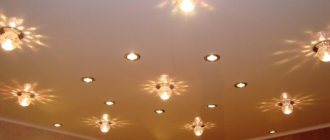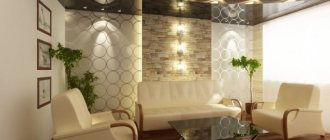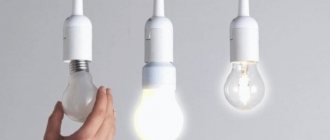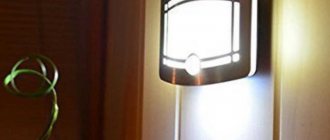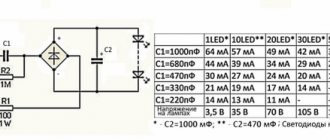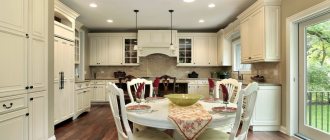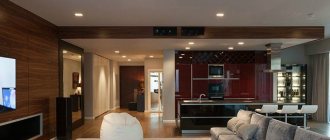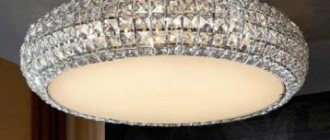How to calculate the number of lamps
Before you think about how to place the lamps on the ceiling, you need to calculate the number of light sources. Basic Rules:
- It is necessary to take into account the presence of reflective surfaces in the room. The more there are, the fewer lamps will be required for lighting.
- Before counting the number of lamps, you need to decide on their type.
- When making calculations, it is important to rely on room illumination standards. Approximate indicators are shown in the table.
Illumination standards
| Room | Indicator, Lux |
| Kitchen, dining room | 150 |
| Children's room | 200 |
| Hall, bathroom, hallway, | 50 |
| Library, office | 300 |
| Wardrobe | 75 |
There are several methods for accurate calculations. Let's talk about the three most popular.
Online calculator
You can find special calculators on the websites ledeffect.ru, potolki-podvesnie.ru, calc.ru, where the necessary formulas for calculations are already integrated. To get the result, just enter individual data in the form fields. Calculations may vary depending on the type of calculator, so experts consider this method not entirely objective.
The photo shows the Ledeffect online calculator. For calculations using other services, similar data will be required.
An example of a calculator for calculating the number of lamps
Formula
There are several formulas that can be used to determine the number of lamps per room. We suggest using the simplest and most understandable one.
First you need to calculate the brightness of the study, which is measured in lumens. To do this, you can use the formula: X=A*B*C.
Let's understand the notation:
- A is the standard illumination for a specific room.
- B is the area of the room in square meters.
- C is the ceiling height coefficient.
Coefficients for ceilings of different heights
| Height, m | Indicator for formula |
| up to 2.7 | 1 |
| 2,7-3,5 | 1,5 |
| 3.5 and above | 2 |
After calculating the optimal brightness, you can begin to calculate the number of lamps. To do this, the resulting indicator must be divided by the power of one lamp of the selected type. The parameters of different light sources are presented in the photo.
Power of different types of lamps
Special programs and applications for lighting calculations
Unlike online calculators, such programs allow you to get accurate indicators. This is an excellent opportunity to include in the study not only the area of the room and lighting standards, but also the architectural features of the premises. Using the program, you can also determine how best to position the lamps on the ceiling. Application examples: Dialux, Ulysse, Europic.
Lighting with ceiling lamps
Posting rules
To understand exactly how to position the lamps, the first thing you should do is learn how to do exactly what you shouldn’t do. Experts do not recommend:
- Place lamps less than 20 cm from the walls.
- Leave a distance of less than 30 cm between the spotlights themselves.
- Place light bulbs closer than 15 cm to the seams in the PVC stretch ceiling.
Important! If the prescribed intervals are not observed, the devices will overheat, which will lead to rapid failure. And if located close to the joints, the seams themselves may come apart.
When choosing lighting fixtures, be sure to consider the following factors:
- Room size. The larger it is, the more lamps will be required.
- Ceiling height. The higher you go, the brighter the light needed.
- Characteristics of window openings. Which side do they go on, what dimensions do they have, how many are there.
- Purpose of the premises. In the passage corridor, the importance of bright lighting is much lower than in the kitchen work area.
- Availability of other light sources. Will the spots be on their own or as an addition to the central chandelier?
How to calculate the distance between lamps
The distance between lamps is primarily affected by the layout of the elements. However, regardless of it, the optimal distance is 30-40 cm. If the lamps are bright, the distance can be reduced to 20 cm.
If the room provides additional lighting through sconces, floor lamps and table lamps, the number of ceiling lights can be reduced. Accordingly, the distance between them will be greater.
And again we remind you of the importance of reflective elements in the interior. If there are mirrors and glossy surfaces in the room, the streams of light will be evenly scattered throughout the room. In this case, the distance between the lamps can be increased.
An example of the arrangement of lamps at a large distance from each other
An example of placing lamps close to each other
Advice! When calculating the distance between lamps, it is important to take into account the type of ceiling structure. The tension fabric may not withstand excessive load, so you should not “partially” with the elements.
Optimal solutions
Stretch fabric has great decorative potential, which is realized with the help of lamps. There are many ideas for placing ceiling lighting fixtures. They are based on the uniformity of lighting, but take into account the features of the interior or the shape of the room. If there are decorative plasterboard structures, then the placement of lamps follows their shape, decorating and emphasizing the design elements.
Spot devices are installed around the perimeter of the room, or grouped in the center. In the latter case, the distance between them may be significantly less than the recommended values, but the overall brightness is compensated by a decrease in the power of individual point elements. A method of decorating a canvas that imitates a starry sky is often used, when the entire surface is filled in a chaotic manner with small lamps.
Important! It is most convenient to design a square ceiling, which allows you to create strict geometric groups. It is more difficult to choose a style in long and narrow rooms, when the distance between the long walls is small and greatly limits design possibilities. In such situations, additional elements installed on walls or other surfaces are used, and the ceiling slab is left free.
Before starting work, you should carefully consider and draw up a diagram of the location of point devices with the obligatory indication of the distances between them. This will help you find them after installing the tension fabric.
Features of lamps for suspended ceilings
Stretch ceilings are considered the most attractive and aesthetic finishing solution. An important point is that you need to think through lighting options in advance in order to install the lamps at the same time as the canvas. PVC film also begins to melt at a temperature of 60-70°C, so only certain types of lamps are suitable.
You also need to immediately decide on the design of the lamps and the type of their attachment to the surface. Let's look at the available instrument options.
Spotlights
Point devices are products whose body is completely built into the ceiling structure or protrudes slightly beyond it. They are suitable both as sources of general lighting and for backlighting. With the help of spotlights, you can implement various lighting scenarios and transform the interior of a room.
The method of installation of devices will depend on their type. Built-in models are fixed in the ceiling thanks to a special spring mechanism. Adjustable stands are used to place overhead lamps. The body of the product is fixed using special thermal rings.
Spotlights in the interior
Pendant lamps and chandeliers
Compact chandeliers and lamps in shades are also suitable for installation on suspended ceilings. It is better to give preference to models with downward-facing lamps. This design of the products will eliminate overheating of the ceiling materials and the appearance of glare.
Important! The main task during installation is to ensure that the device body is located at a distance of at least 10 cm from the ceiling surface.
To be able to place pendant lights and chandeliers, a durable hook must be integrated into the base ceiling before installing the tension fabric. It is needed to attach a chain or cable that holds the frame of the lamps. Don't worry that the design will be noticeable - it will disappear behind the canvas. Only the chandelier itself and a fragment of the fixing cable will appear to the eye.
Chandelier in the interior of the room
Pendant lamps in the interior of the room
Raster lamps
Raster lamps are compositions of fluorescent lamps enclosed in reflective structures. This is an ideal choice for spacious rooms that require bright lighting. However, the products will not please you with an impressive design - they look as laconic as possible.
Installing such lamps is easy. It is enough to provide several holes of suitable dimensions in the tension fabric.
Raster lamps in the interior of the room
Track lights
Track lights are light elements located on the busbar. The lamps can be moved and rotated to a convenient position. Such products are indispensable for creating accent lighting and lighting compact rooms.
To fix the track lights to the tension fabric, special built-in elements are used - it is on them that the busbar will be attached. This design is completely safe for ceiling materials.
Track lamps in the interior of the room
LED lights
For additional lighting, you can use a monochrome or color LED strip. With its help it is easy to create various patterns and light patterns on a stretch ceiling.
The main advantage of the tape is that it does not generate heat. It can be safely mounted directly on the tension fabric.
LED ceiling light
Types of lighting fixtures
Based on their design, lighting fixtures are divided into four groups.
Chandeliers
They are still in demand, despite the emergence of more modern accessories. Manufacturers offer a good selection of models: from classically shaped lampshades to designer options made from unusual materials. To prevent the stretched panel from heating up, it is better to choose designs whose shades look down or to the side. It should be taken into account that the glossy surface reflects light. Therefore, chandeliers with shades will look good here. For film material, the distance to the heating zone is critical, so it is better to choose a longer chandelier suspension.
Photo: Instagram @_marina_ky
Photo: Instagram @_marina_ky
Photo: Instagram @_marina_ky
Spot
They are at the peak of popularity, which is not surprising: they do not heat up, have different mounting options, are durable and simply beautiful. Since the kitchen is often humid, it is better to choose models with a moisture-proof housing. To obtain bright or diffused light, you can choose transparent or frosted glass, respectively. And with the help of colored glass you can create unusual patterns on the surface. During installation, you can make electrical wiring to turn on the lights only in the areas needed at the moment. To calculate the required number of spotlights, you need to know the generally accepted lighting standard. It is 20 W per 1 sq.m of room.
Photo: Instagram @vgceiling
Photo: Instagram @mix_svet
Photo: Instagram @migcomservice
Spots
A variety of point models that are not built into the ceiling surface, but are attached to it or to the walls on a movable bracket. Due to their mobility, they create a directed beam of light. The control controller helps you adjust the intensity of the glow. These types are good for zoning a room, illuminating the desired part of it, or focusing attention on interior details. Spots can be single or complex, with several cartridges on one platform. If the spot itself is rather ascetic in appearance, then the platform can become an interior decoration.
Photo: Instagram @mix_svet
Photo: Instagram @prinesibobra
- Ceiling
How to make a stretch ceiling with lighting: useful tips and 72 photo examples
LED strips
The design looks like a flexible printed tape on which small LEDs, white or colored, are attached. Such ribbons run around the perimeter of the room, visually increasing its area. The reverse side of the tape is sticky, so it is easy to attach. The tape is connected to the network via a power supply. And controllers are used to control the brightness of the glow.
Photo: Instagram @migcomservice
Photo: Instagram @horizon_line_krd
- Lighting
9 ways to make your home more comfortable with LED strips
How to place lamps on the ceiling: diagrams
Regardless of the number and type of devices, it is important to follow the basic rules for the location of lamps. The minimum distance from the light point to the edge of the ceiling should be at least 20 cm. If the structure is tensioned, an indentation should also be made from the seams - at least 15 cm.
We offer several popular lighting layouts. You will find interesting options for different numbers of lamps.
With chandelier
In such a scheme, the chandelier becomes the main accent. Additional sources include overhead or spotlights.
The position of the chandelier is simple - it is better to place it in the center of the ceiling. But the layout for the placement of spots should be chosen depending on the purpose of the room and its dimensions. The photo shows common combinations with different numbers of lamps.
Examples of placement of lamps in the presence of a chandelier
For small rooms, corner placement of spots is preferable. The lighting will be moderately bright and uniform.
If the room is square, it is better to place lamps around the chandelier. Thanks to this technique, the illuminated room will seem much more spacious.
For rectangular rooms, an oval or arc-shaped arrangement of additional elements is suitable. If the room is very spacious, you can add lamps in the corners.
With pendant lights
If you don’t know how to place lamps on a suspended ceiling, you can use diagrams for lighting design with a chandelier. However, if there is more than one pendant lamp, you will have to vary the number of additional elements. Examples of location are shown in the photo.
Examples of placement of spotlights and pendant lamps
Without chandelier
If there is no chandelier in the interior, you can organize the main lighting using spots. We need to decide how to place the elements. There are no strict rules - designers actively experiment with schemes, observing basic requirements.
If you need a ready-made solution for how to arrange 6, 8 or more lamps, consider the optimal design options.
Examples of placement of ceiling lights without a chandelier
Advice! If there are a lot of lamps, it is better to “split” them into groups and distribute them by zones or brightness. In this case, you can change the light level in a certain part of the room.
Spot layouts with a chandelier
No matter how archaic a chandelier sometimes looks, sometimes without it some rooms look downright boring.
The use of spots as additional lighting does not at all downplay their role as light sources. As can be seen from the set of the most common schemes, they are responsible for zoning the room and the necessary lighting of certain areas noticeably distant from the central chandelier.
Let's look at how this is implemented in practice.
Types of ceiling lighting
In the last century, houses and apartments were illuminated using a variety of incandescent lamps. The chandelier was usually hung in the center, and if the room was large, only its central area was illuminated. Therefore, the chandelier was supplemented with other lighting fixtures that create diffused light: floor lamps, sconces and table lamps. The combination made it possible to obtain a well-lit and cozy space.
When spotlights (spots) appeared, it turned out that they could complement classic lamps, or be used independently. The main difference between the spots turned out to be their small dimensions and the ability to create a powerful directed stream of light.
This is how they differ from backlights, modern devices that create diffuse lighting. The backlight can be completely hidden from view by a suspended or suspended ceiling, or another structure (for example, a plasterboard box).
A ceiling that helps zone a room Source plentymarkets.com
Spots are mounted on a suspended or tensioned structure. They are always positioned so that the body is hidden above the finishing material, and only the front surface is visible to the eye. Thanks to the hidden location, the desired effect is created: the feeling that the light is coming from one point.
Due to the nature of the device, recessed luminaires are not used as single sources. Several spots are a good addition to a regular chandelier, but they are often used solo, especially in modern interiors.
For any method of use, the location of spotlights on the ceiling becomes important. The attractiveness and comfort of the room will depend on whether they are distributed over the entire ceiling area or occupy certain areas.
How to choose light for the corridor: universal design tips
When choosing interior elements and lighting, designers are always guided by professional principles. Before you start purchasing light sources, you should understand general organizational issues. 4 important recommendations from experts:
- It is better if the light in the corridor is warm. Cold shades of the spectrum make the room overly formal and uncomfortable. However, some interior styles require just such hallway lighting. In this case, you will have to use a limited number of devices.
- The main criterion for general lighting in the hallway is the brightness of the light. You must be well oriented in space and distinguish all interior items. It is unacceptable to have “blind spots” where the flow does not enter. This should be taken into account when designing the circuit in order to determine the location of the devices in advance.
- It is important to know safety rules and actively use them when creating a lighting project. Lighting devices in the hallway of the apartment should be located so that they cannot be accidentally damaged or moved out of place. This rule is especially relevant in houses where children live.
- You should not combine several completely different lighting sources in one of the hallways. To create an unusual ensemble, it is better to use universal and accent elements. For example, neutral spotlights go well with hanging chandeliers decorated with colored shaped shades.
Important! Designers have a rule - no matter what lighting fixtures are chosen, you need to make sure that there are no glares on the smooth surfaces in the hallway. If there are mirrors in your hallway, it is better to place lamps on both sides of the objects or on top directly above them.
Original lighting in the hallway
Multi-level lighting in the hallway
Features of rooms and location of lamps
Sometimes spots are simply necessary. For example, there may be a chronic lack of natural light in the room (if the windows face north, or there is a tall building opposite). In such an environment they will be used during the daytime.
Scheme for a two-level ceiling in the kitchen Source decorilla.com
Common problems and their solutions
The main problem that arises when choosing a layout is the lack of canvas area. The distances between elements become too small, causing sharp spots of light to form. They interfere with the correct perception of the design intent and irritate the visual organs. A ceiling with spotlights should be designed evenly, without excesses or empty areas. The solution to the problem is to use different types of lamps; in addition to point elements, you can add wall or hanging structures. If the distances between devices are too small, their power should be reduced. This will distribute the illumination more evenly and eliminate dark spots.
Important! Rooms that are too large require additional sources. They can be separate groups, or enhance the main lighting line. The main problem that should be solved in such situations is uniformity of distribution, reducing large distances between groups.
Zoning as an option for lighting the hallway and corridor
There is not only basic, but also local lighting of the corridors. If there are decorative objects or furniture in the hall, you can highlight them favorably, turning them into the highlight of the interior. Also, with the help of light it is easy to visually divide the space into zones.
Illumination of the stairs in the corridor
If there is a staircase in the hallway, it is permissible to highlight it with light. Two suitable options for implementing the idea: lamps built into the steps or sconces on the walls. Illumination eliminates the need to turn on all the lamps in the corridor. The leading argument for the implementation of this idea is the safety of your household, who will now be able to climb the stairs without problems in the dark.
Combined lighting of the stairs in the corridor
Illumination of staircase steps in the corridor
Illumination of racks and shelves
Is there a shelf in the hallway? You can put a compact table lamp there. It is better to decorate a full-fledged rack with an LED strip, placing it around the perimeter of the furniture. Designers also often use small lamps on clothespins, which are easily mounted directly to the shelves. The only inconvenience of this method is the need for a sufficient number of free sockets to connect elements.
Illumination of shelves with spotlights
Illumination of paintings and mirrors in the hallway
You can install an LED strip or small rotary spotlights around the perimeter of the element. Several identical wall sconces and lamps in the form of street lamps look extravagant. However, you should not choose too bright light bulbs - soft, dim light is enough.
Illumination of mirrors and paintings in the corridor
Video description
About the rules for the placement of lamps in the following video:
What influences the choice of scheme
When choosing how to position luminaires, you often have to take into account the following variables:
- Daylight. It is not so much the level of daylight that is taken into account, but its presence. In a hallway or bathroom, the standard requires one lamp per 1.5 square meters; in a bedroom or living room, each source is allocated 2 square meters.
- Furniture arrangement. When developing a scheme, you need to clarify where tall pieces of furniture will be located. It is unpleasant if after installation it turns out that a tall cabinet is blocking part of the lamps: the ceiling panel has already been cut through, and there may be no other place for the cabinet.
- Additional characteristics. Not only the glow power is important, but also the color temperature of the lamps. The range of 2700-3000 K corresponds to the warm light of incandescent lamps. Neutral, close to daylight, lighting for lamps with a temperature of 4000-4300 K. The range of 5000-6500 K makes the light cold (like on a cloudy day).
Standard layout for a small corridor Source ikea.com
- Room zoning. If a dedicated ceiling light is planned (for example, for a relaxation or work area), it is important to coordinate it with the entire scheme. The priority should be comfort and harmony of the main and local light flux.
- Additional lighting. The scheme will change if you decide to add an LED strip on the stretch ceiling, or plan to place a floor lamp near the sofa.
